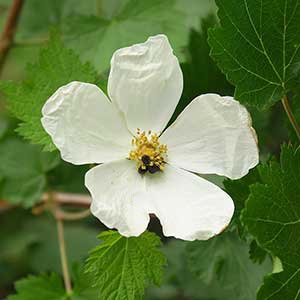Rubus bartonianus
Rubus parviflorus
Barton's raspberry, bartonberry
snow bramble, thimbleberry
erect, sparsely short-hairy, glabrescent, eglandular, not pruinose.
biennial, erect, sparsely hairy, glabrescent, moderately stipitate-glandular, glands yellowish to reddish, not pruinose.
deciduous, simple;
stipules lanceolate, 4–6 mm;
blade cordate to broadly ovate, (2–)2.5–4(–5) × (2.5–)3.5–4.5(–5.5) cm, base deeply cordate, 3–5-lobed, lobe apices acute to obtuse, margins coarsely doubly dentate, abaxial surfaces glabrous or sparsely hairy, eglandular or sparsely stipitate-glandular.
deciduous, simple;
stipules lanceolate to ovate, 5–15 mm;
blade orbiculate to reniform, 5–20 × 5–25 cm, base cordate, palmately, shallowly to moderately deeply, (3–)5(–7)-lobed, margins coarsely, irregularly serrate to doubly serrate, apex shortly acuminate to obtuse, abaxial surfaces glabrate to densely hairy, sparsely to moderately stipitate-glandular, glands yellowish to reddish.
1-flowered.
terminal and axillary, (1–)3–7(–15), cymiform to thyrsiform.
moderately hairy, eglandular or sparsely stipitate-glandular.
sparsely to moderately hairy, moderately to densely stipitate-glandular, glands yellowish to reddish.
bisexual;
petals white, obovate, (15–)20–25 mm;
filaments filiform;
ovaries glabrous, styles clavate, villous.
bisexual;
petals white, broadly obovate, (10–)14–22(–28) mm;
filaments filiform;
ovaries distally densely hairy, styles clavate, glabrous.
deep red, hemispheric, to 1 cm;
drupelets 10–30, coherent, separating from torus.
red, hemispheric, 1–1.8 cm;
drupelets 50–60, coherent, separating from torus.
= 14.
Rubus bartonianus
Rubus parviflorus
Of conservation concern.
Rubus bartonianus is distinguished from the other flowering raspberries within its geographic range by its erect, unarmed stems, relatively small, simple leaves with acute to obtuse lobes, deeply cordate bases, sparsely hairy or glabrous abaxial surfaces, relatively large flowers with white petals, and densely long-hairy, clavate styles. The leaves superficially resemble those of Acer glabrum or some species of Ribes.
Rubus bartonianus is most similar to R. neomexicanus but especially R. deliciosus. The species is known only from the Snake River Canyon of Idaho and Oregon.
(Discussion copyrighted by Flora of North America; reprinted with permission.)
Rubus nutkanus is distinguished from other flowering raspberries by its erect, unarmed stems, simple leaves, large flowers, white petals, glabrous, clavate styles, and yellowish to reddish stipitate glands covering most plant parts. A hybrid with R. odoratus (R. ×fraseri Rehder) is thought to occur in areas of overlap in northern Michigan (E. G. Voss 1972–1996, vol. 2). Varieties and forms have been described based on indument and glandularity of stems, leaves, petioles, pedicels, and sepals (for example, M. L. Fernald 1950). Different variants often occur mixed in the same population and generally do not correspond to definite geographic regions (N. C. Fassett 1941). Plants from coastal California (considered as var. velutinus) tend to have densely hairy leaf abaxial surfaces; this variation may be environmentally induced; other Rubus species show the same pattern (for example, R. spectabilis var. franciscanus) in that area. Wild thimbleberries are collected in Keweenaw Peninsula, Michigan, and are used in beverages and especially for jam.
Rubus nutkanus is typically associated with western North America but was originally described from plants at its eastern range limit in northern Michigan. The Great Lakes populations are disjunct from western mountain populations by around 600 miles.
The name Rubus parviflorus var. grandiflorus Farwell, which applies here, is illegitimate.
(Discussion copyrighted by Flora of North America; reprinted with permission.)
- Local floras:
BC,
CA,
OR,
WA
- Local Web sites:
CalFlora,
CalPhotos,
Flora NW,
IL Wildflowers,
MI Flora,
MN Wildflowers,
PNW Herbaria,
Turner Photog.
WildflowerSearch
iNaturalist (observations)
USDA Plants Database
- LBJ Wildflower Center
- SEINet
- Plants of the World Online
- Encyclopedia of Life
- Wikipedia
- Google Image Search


